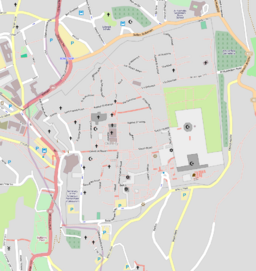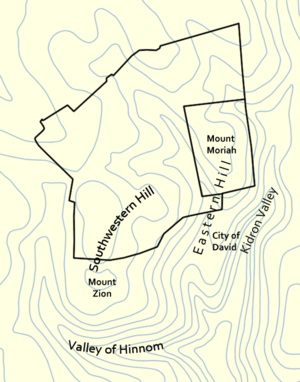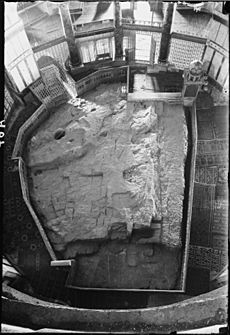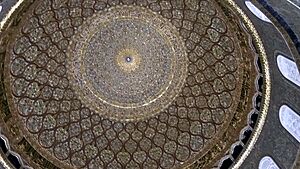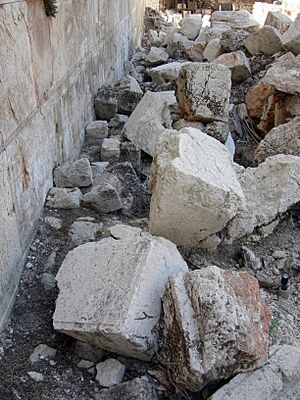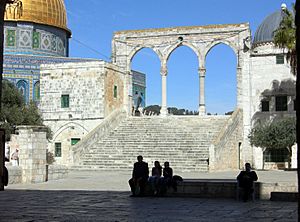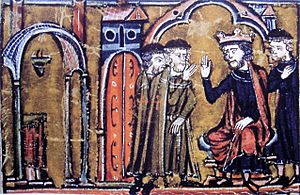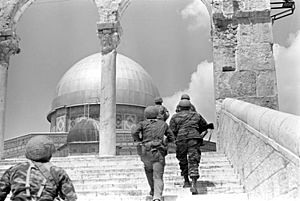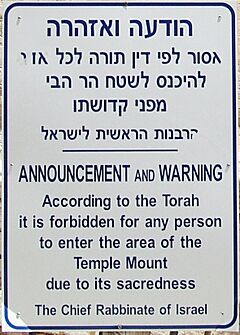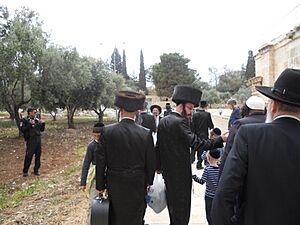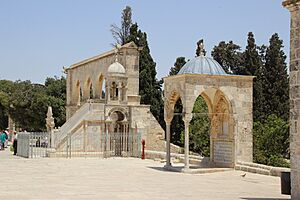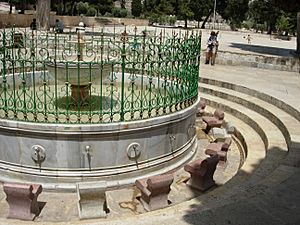Temple Mount facts for kids
Quick facts for kids Temple Mount |
|
|---|---|
| Har haBayit Haram al-Sharif Jerusalem's sacred (or holy) esplanade |
|
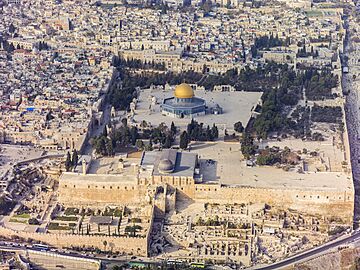
Aerial view of the Temple Mount
|
|
| Highest point | |
| Elevation | 740 m (2,430 ft) |
| Geography | |
| Parent range | Judean |
| Geology | |
| Mountain type | Limestone |
The Temple Mount is a very important hill in the Old City of Jerusalem. Long ago, two Jewish Temples stood here. Today, it is home to a large Islamic area called Al-Aqsa (also known as Haram al-Sharif). This area includes the Al-Aqsa Mosque and the Dome of the Rock. For thousands of years, people from Judaism, Christianity, and Islam have considered this place very holy.
The area you see today is a flat plaza. It is surrounded by strong walls, including the famous Western Wall. These walls were first built by King Herod about 2,000 years ago. He built them to make the Second Jewish Temple bigger. The plaza has two main buildings. These were built after the city was captured in 637 CE. They are the main prayer hall of al-Aqsa Mosque and the Dome of the Rock. The Dome of the Rock was finished in 692 CE. This makes it one of the oldest Islamic buildings still standing. You can enter the site through eleven gates. Ten gates are for Muslims, and one is for non-Muslims. Israel Police officers are usually near each gate.
The Temple Mount is the holiest place for Jewish people. It is where their two ancient Temples once stood. Jewish tradition says that the First Temple was built by King Solomon around 957 BCE. It was destroyed in 587 BCE. The Second Temple was built later, around 516 BCE. King Herod made it even grander. But it was also destroyed by the Roman Empire in 70 CE. Many Jewish people believe a third Temple will be built here when the Messiah arrives. When Jewish people pray, they often face towards the Temple Mount. Because it is so holy, some Jews do not walk on the Mount itself. They want to avoid accidentally stepping on the spot where the Holy of Holies was. This was the most sacred part of the Temple.
The Al-Aqsa mosque compound is one of the three holiest sites in Islam. It is called "the Noble Sanctuary." Its large courtyard can hold over 400,000 worshippers. This makes it one of the biggest mosques in the world. For Muslims, it is the third holiest site. Muslims believe that the prophet Muhammad ascended to heaven from this spot. It was also the first "qibla" (direction) Muslims faced when praying. Muslims also connect this site with Solomon and other prophets. The site is also a very important symbol for Palestinians, including Palestinian Christians.
Since the Crusades, the Muslim community in Jerusalem has managed the site. This is done through the Jerusalem Islamic Waqf. The site, along with East Jerusalem, was controlled by Jordan from 1948 to 1967. Since the Six-Day War in 1967, Israel has occupied it. After capturing the site, Israel gave its management back to the Waqf. This was under Jordanian Hashemite custodianship. However, Israel keeps security control. The Israeli government does not allow non-Muslims to pray on the site. This is part of an agreement called the "status quo." The Temple Mount is a major focus point in the Israeli–Palestinian conflict.
Contents
Different Names for the Site
The name of this important site is sometimes debated. This is often because of the ongoing Israeli–Palestinian conflict. People from different backgrounds use different names. In 2016, the head of UNESCO said that different people worship in the same places. They sometimes use different names for them. She said it is very important to respect all these names.
Temple Mount
The name Har haBayīt in Hebrew means "Mount of the House." It is often translated as "Temple Mount" in English. This name was used in ancient Jewish texts. It refers to the mountain where the Jewish Temples stood.
Other Hebrew Names
Ancient texts also call the Temple Mount by other names. One is Mount Moriah. This is where the Bible says Abraham was asked to sacrifice his son, Isaac. Another name used was Mount Zion. Over time, the name Mount Zion moved to a different hill in Jerusalem.
Al-Aqsa Mosque
The English term "al-Aqsa Mosque" comes from the Arabic al-Masjid al-'Aqṣā. This means "the farthest mosque." It is mentioned in the Quran in the story of Muhammad's Night Journey. In this story, Muhammad traveled from Mecca to this mosque. From there, he went up to heaven. Many early Islamic scholars believed "al-Aqsa Mosque" referred to the entire plaza. This includes the Dome of the Rock, fountains, gates, and minarets. This is because these buildings did not exist when the Quran was written.
The term al-Jâmi' al-Aqṣá refers specifically to the silver-domed building. This is the main prayer hall, also called the Qibli Mosque. It is at the southern end of the compound.
Haram al-Sharif
During the time of the Mamluk and Ottoman empires, the wider area became known as Haram al-Sharif. This means "the Noble Sanctuary." This name made the compound as important as other holy sites in Islam. These include the Masjid al-Haram in Mecca and the Al-Masjid an-Nabawi in Medina.
Jerusalem's Sacred Esplanade
Some experts use the term "Sacred Esplanade" or "Holy Esplanade." They use it as a neutral way to describe the site. This term helps avoid taking sides in the naming debate.
Location and Size
The Temple Mount is on a narrow hill that slopes down from north to south. It rises above the Kidron Valley to the east and the Tyropoeon Valley to the west. Its highest point is about 740 meters (2,428 feet) above sea level. Around 19 BCE, Herod the Great made the natural flat area much larger. He did this by building four huge walls and filling in the spaces. This made a very large flat area. Today, this area forms the eastern part of the Old City of Jerusalem.
The platform is shaped like a trapezoid. It is about 488 meters (1,601 feet) long on the west side. It is 470 meters (1,542 feet) on the east side. It is 315 meters (1,033 feet) on the north side. And it is 280 meters (919 feet) on the south side. This gives it a total area of about 150,000 square meters (37 acres). The northern and part of the western walls are hidden by buildings. The southern part of the western wall is visible. This is where the Western Wall is located.
World Heritage Site
In 1980, Jordan suggested that the Old City of Jerusalem be listed as a UNESCO World Heritage Site. It was added to the list in 1981. In 1982, it was also added to the List of World Heritage in Danger.
In 2016, UNESCO passed a resolution. It talked about "escalating Israeli aggressions" and illegal actions against the Waqf. It asked for Muslim access to be restored. It also asked Israel to respect the historical "status quo." The resolution referred to the holy hilltop compound only by its Muslim name, Al-Haram al-Sharif. Israel criticized this for not mentioning "Temple Mount." Israel then stopped all ties with UNESCO. In October 2017, Israel and the United States announced they would leave UNESCO. They said it was biased against Israel. In April 2022, UNESCO adopted another resolution about Jerusalem.
Religious Importance
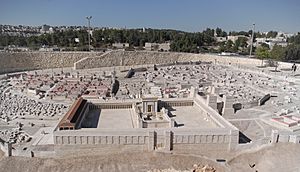
The Temple Mount is very important to all three major Abrahamic religions: Judaism, Christianity, and Islam. It is especially important for Judaism and Islam.
Judaism
The Temple Mount is the holiest site in Judaism. Jewish tradition says that both the First and Second Temples stood here. It is also believed to be the place of other important Bible events. These include the Binding of Isaac and Jacob's dream. The Foundation Stone under the Dome of the Rock is believed to be where the world began. Many Jewish people believe the third and final Temple will be built here. This will happen when the Messiah comes.
Jewish people pray facing the Temple Mount. Because of its extreme holiness, many Jews do not walk on the Mount itself. They want to avoid entering the area where the Holy of Holies was. This is because Jewish law says there is still a special divine presence there.
The Temples
The Hebrew Bible says the Temple Mount was once a threshing-floor. King David bought this land. He built an altar there. Later, his son Solomon built the First Temple. This Temple was the center of Jewish life. It housed the Ark of the Covenant. The most sacred part was the Holy of Holies. Only the High Priest could enter it once a year.
The First Temple was destroyed in 587 BCE by the Babylonians. The Jewish people were sent away to Babylon. Later, they were allowed to return. In 516 BCE, they rebuilt the Temple. This was the Second Temple. King Herod later made it much bigger and more beautiful. But the Romans destroyed it in 70 CE. Jewish people remember these destructions on a special fast day called Tisha B'Av.
In Prophecy
The Book of Isaiah in the Bible talks about the Temple Mount's future importance. It says that in the future, people from all nations will come to this mountain to learn God's ways.
Binding of Isaac
Jewish tradition also believes the Temple Mount is where Abraham was asked to sacrifice Isaac. This place is called Mount Moriah in the Bible.
Creation of the World
Jewish sages believe the Foundation Stone under the Dome of the Rock is very special. They say it is the spot from which the world was created. It is also where God gathered the dust to create the first human, Adam.
Third Temple
Jewish texts predict that a Third and final Temple will be built on the Mount. This will happen when the Messiah comes. Many Jewish prayers ask for the Temple to be rebuilt. Some Jewish groups actively work towards building the Third Temple.
Christianity
The Temple was very important in Jewish worship in the Old Testament. In the New Testament, Herod's Temple was where many events in the life of Jesus happened. After the Temple was destroyed in 70 CE, Christians saw it as a fulfillment of Jesus's prophecy. The Temple Mount became less important for Christian worship. Christians focused on other holy sites in Jerusalem, like the Church of the Holy Sepulchre.
During the Byzantine era, Jerusalem was mostly Christian. Many pilgrims visited the places where Jesus walked. After the Persian invasion in 614, many churches were destroyed. The Temple Mount became a rubbish dump. When the Arabs conquered the city in 637, Jews were allowed to live in the city again. Christian pilgrims could also visit the Temple Mount area.
When the Crusaders captured Jerusalem in 1099, they used the Al-Aqsa Mosque as their headquarters. They called it "Solomon's Temple." The Knights Templar believed the Dome of the Rock was the site of Solomon's Temple. They set up their base in al-Aqsa Mosque. In 1187, Saladin retook Jerusalem. He removed all Christian signs from the Temple Mount. He returned the Dome of the Rock and al-Aqsa Mosque to Muslim use.
Most Christians today do not see pilgrimage to the Temple Mount as a main part of their faith. The New Testament teaches that worship is about spirit and truth, not just a physical place.
Islam

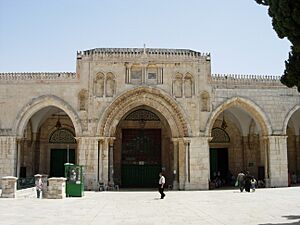
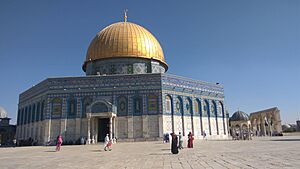
For Muslims, the entire plaza, known as the al-Aqsa Mosque or Haram al-Sharif, is the third holiest site in Islam. Islamic tradition says this is where Muhammad ascended to heaven from Jerusalem. It was also the first direction Muslims faced when praying. Muslims also connect the site with Abraham and other prophets. They see it as one of the earliest places to worship God.
In Early Islam
After the Muslim conquest of Jerusalem in 638 CE, Caliph 'Omar ibn al Khatab reportedly cleaned the site. He then allowed Jews to access it. He chose to build a mosque to the south of the Rock. This became known as al-Aqsa Mosque. Muslim sources say Jews helped build the area.
Muslims believe the Mount is the site of the Temple built by Solomon, who is a prophet in Islam. They believe it was later destroyed. After it was built, Muslims believe prophets like Jesus used it to worship God.
Isra and Mi'raj (Night Journey)
The Quran describes Muhammad's Night Journey. He was taken from the Great Mosque of Mecca to a place called Al-Aqsa Mosque. This means "the furthest place of prayer." From there, he went up to heaven. He met other prophets and led them in prayer.
Later Islamic texts identified this "furthest place of prayer" with Jerusalem. The Dome of the Rock was built in 691 CE around the sacred rock. The Al-Aqsa Mosque was built in 715 CE. The term "Noble Sanctuary" or "Haram al-Sharif" refers to the entire area around the Rock.
First Qibla
For about 16 or 17 months after moving to Medina, Muslims prayed facing al-Aqsa. This made it the first qibla (direction of prayer). Later, Muhammad received a revelation. Muslims then began to pray facing the Kaaba in Mecca.
History of the Site
Early Periods
The hill is believed to have been lived on since about 4,000 BCE. An ancient amulet from an Egyptian pharaoh was found there.
Israelite Period
According to archaeologists, the Temple Mount was the center of religious life in ancient Jerusalem. The First Temple was likely part of a larger royal complex. The Bible mentions other buildings Solomon built there, like his palace. The First Temple was destroyed in 587/586 BCE by the Babylonians.
Later Ancient Periods
The Second Temple was built around 516 BCE. It was on the same spot as Solomon's Temple. Later, Herod the Great made the Temple Mount much larger. He rebuilt the Temple to be very grand. This project involved 10,000 workers. It made the Temple Mount the largest sacred area in the ancient world.
The main entrances were two sets of gates in the southern wall. There were also gates on the western side. Large covered walkways surrounded the platform. The Temple itself was on a raised platform in the middle. Herod also built the Antonia Fortress and a water reservoir.
During the First Jewish–Roman War (66–70 CE), the Temple Mount was a battleground. In 70 CE, the Roman army under Titus captured Jerusalem. They completely destroyed the Temple and all other buildings on the platform. Large stones from the walls were found burned and collapsed.
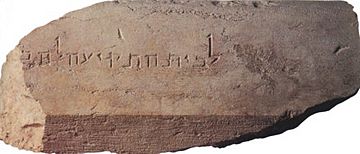
After the destruction, the Roman city of Aelia Capitolina was built in 130 CE. The Roman emperor Hadrian built a temple to Jupiter on the Temple Mount. This was seen as disrespectful by Jews. After a Jewish revolt, Jews were forbidden from entering the city.
Byzantine Period
Christianity became the main religion in the Roman Empire. Emperor Constantine I ordered the temple to Jupiter on the Temple Mount to be destroyed. The site became a desolate rubbish dump. In 363 CE, Emperor Julian allowed Jews to rebuild the Temple. But this effort was stopped by an earthquake and other events.
Early Muslim Period
In 637 CE, Arabs captured Jerusalem from the Byzantine Empire. There are many stories about how the main Islamic buildings were started. One story says that Caliph 'Omar found the site covered in rubbish. He had it cleaned and allowed Jews to access it. He built a mosque there, which became known as al-Aqsa Mosque.
In 691 CE, Caliph Abd al-Malik built the Dome of the Rock around the sacred rock. In 715 CE, the Umayyads built the Al-Aqsa Mosque. The entire area became known as "Haram al-Sharif" or "Noble Sanctuary."
Crusader and Ayyubid Periods
The Crusaders captured Jerusalem in 1099. The Knights Templar used the Al-Aqsa Mosque as their headquarters. They called it "Solomon's Temple." In 1187, Saladin retook Jerusalem. He removed all Christian signs and returned the Dome of the Rock and al-Aqsa Mosque to Muslim use.
Mamluk and Ottoman Periods
Many Mamluk buildings were added to the Haram area. These include schools and fountains. The Ottomans continued the policy of not allowing non-Muslims on the Temple Mount until the early 1800s.
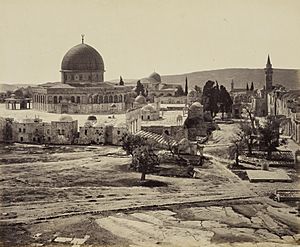
In 1867, a British team explored tunnels near the Temple Mount walls. They were the first to document the lower parts of the walls.
British and Jordanian Periods
Between 1922 and 1924, the Dome of the Rock was restored. Renovations were also done at the Al-Aqsa Mosque from 1938–1942.
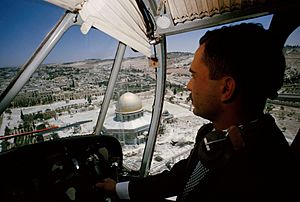
Jordan carried out two more renovations of the Dome of the Rock. Neither Israeli Arabs nor Israeli Jews could visit their holy places in Jordanian areas during this time.
Israeli Period
On June 7, 1967, during the Six-Day War, Israeli forces took control of the Old City of Jerusalem, including the Temple Mount. The Israeli Chief Rabbinate declared a holiday called "Yom Yerushalayim" (Jerusalem Day). This celebrates the reunification of Jerusalem. Many saw the capture of Jerusalem as a miracle.
In June 1969, an Australian man set fire to the Jami'a al-Aqsa. In 1982, a Jewish man shot people in the Dome of the Rock. In 1974, 1977, and 1983, groups tried to blow up the Dome of the Rock and al-Aqsa. In 1984, guards stopped a group trying to infiltrate the area to blow it up.
In October 1990, there were clashes. Palestinian Muslims protested against a group of Jews who wanted to lay a cornerstone for a new Temple. Rocks were thrown, and security forces fired, killing 21 people. An Israeli inquiry found Israeli forces at fault.
Between 1992 and 1994, the Jordanian government covered the Dome of the Rock with gold plates. This cost $8 million. The Temple Mount remains under Jordanian custodianship.
On September 28, 2000, Israeli opposition leader Ariel Sharon visited the al-Aqsa compound. Many Palestinians saw this as a provocative act. Protests erupted, and stones were thrown. Police fired tear gas and rubber bullets. This visit sparked a five-year uprising called the al-Aqsa Intifada.
On January 3, 2023, Israeli Minister of National Security Itamar Ben-Gvir visited the Temple Mount. This caused protests by Palestinians and criticism from several Arab countries.
Status Quo
The "status quo" is an agreement about how the site is managed.
Under Israeli Control
After the Six-Day War in 1967, Moshe Dayan and Muslim religious leaders met. They agreed that Jews could visit the Temple Mount. They had to respect Muslim feelings and act properly. But they were not allowed to pray there. The Western Wall remained the Jewish place of prayer. Muslims kept "religious sovereignty," while Israel had "overall sovereignty." Muslims did not agree with this, as they rejected Israel's control of Jerusalem.
Police continue to forbid Jews from praying on the Temple Mount. Israeli leaders have repeatedly said the status quo will not change. However, some changes have happened:
- Jewish visits are sometimes stopped or limited.
- Jews and other non-Muslims can only visit from Sunday to Thursday, for four hours each day.
- Visits inside the mosques are not allowed.
- Jews who look religious must visit in groups. They are watched by Waqf guards and police.
Many Palestinians worry that Israel plans to change the status quo. They fear Jewish prayers might be allowed, or that al-Aqsa mosque could be damaged.
Management and Access
An Islamic Waqf has managed the Temple Mount since 1187. After Israel took control in 1967, Prime Minister Levi Eshkol promised that holy places would not be harmed. The Knesset passed a law to protect holy places and ensure access. The site is controlled by Israel, but the Waqf manages it.
As a security measure, the Israeli government does not allow non-Muslim prayer on the site. Non-Muslims seen praying are removed by police. Sometimes, Israel prevents Muslim men under 45 from praying in the compound. This happens when there is fear of stone-throwing towards the Western Wall. The Mughrabi Gate is the only entrance for non-Muslims.
Jewish Views on Entering the Site
Because of religious rules about entering the most sacred areas, the Western Wall is considered the holiest accessible site for Jews to pray. In 2013, a Knesset committee discussed allowing Jews to pray at the site. This caused a lot of debate.
Jewish Religious Law
In ancient Temple times, entry to the Mount was limited by complex purity laws. Non-Jews were not allowed into the inner court. A stone found in 1871 had a Greek inscription. It warned that foreigners entering the Temple area would face death.
Maimonides, a famous Jewish scholar, wrote that one could only enter the site for a religious reason. After the Temple was destroyed, there was a debate. Did the site still keep its holiness? Maimonides said yes, the holiness lasts forever. So, the rules about entry still apply. Many rabbis today forbid entering the Temple Mount. They worry about accidentally stepping into the most sacred areas.
Opinions of Rabbis Today
After the Six-Day War, the Chief Rabbinate of Israel warned that Jews were not allowed to enter the site. They said the holiness of the site never ended. This ban was supported by many rabbis.
However, some Modern Orthodox and national religious rabbis encourage visits to certain parts of the Mount. They believe these areas are allowed by Jewish law. These rabbis say visitors must be respectful. They should also perform a ritual washing before entering.
In December 2013, the two Chief Rabbis of Israel repeated the ban. They said, "nothing has changed and this strict prohibition remains in effect." In November 2014, the Sephardic chief rabbi also said Jews should not visit the Mount.
Features of the Site
Courtyard
The large courtyard can hold over 400,000 worshippers. This makes it one of the largest mosques in the world.
Upper Platform
The upper platform surrounds the Dome of the Rock. Underneath it is the Well of Souls. The platform can be reached by eight staircases. Each staircase has an archway called a qanatir.
There is also a smaller domed building called the Dome of the Chain. It is east of the Dome of the Rock. Its exact purpose is not fully known. Two other small domes are to the northwest. The Dome of the Ascension marks where some believe Muhammad ascended to heaven. The Dome of the Spirits is from the 16th century.
In the southwest corner is the Dome of Literature. It is from 1208. A stone pulpit called the "Summer Pulpit" is used for outdoor prayers.
Lower Platform
The lower platform makes up most of the Temple Mount. At its southern end is al-Aqsa Mosque. Gardens are on the eastern and northern sides. An Islamic school is at the far north.
There is also an ablution fountain called al-Kas. It was once supplied by an aqueduct from Solomon's Pools. Now it uses Jerusalem's water system.
Many cisterns are under the lower platform. They collect rainwater. Some are very large, like Cistern 8, known as the Great Sea. It can hold hundreds of thousands of gallons of water.
Gates
- Sealed Gates
The walls have several gates that are now blocked. The Golden Gate is in the eastern wall. Legend says the Jewish Messiah will enter Jerusalem through it. On the southern side are the Huldah Gates. These were the main entrances and exits to the Temple Mount. In the western wall, the Barclay's Gate and Warren's Gate are hidden by later buildings.
- Open Gates of the Haram
There are now eleven open gates to the Muslim Haram al-Sharif. These include:
- Bab al-Asbat (Gate of the Tribes)
- Bab al-Hitta (Gate of Remission)
- Bab al-Atim (Gate of Darkness)
- Bab al-Ghawanima (Gate of Bani Ghanim)
- Bab al-Majlis (Council Gate)
- Bab al-Hadid (Iron Gate)
- Bab al-Qattanin (Gate of the Cotton Merchants)
- Bab al-Matarah (Ablution Gate)
- Bab as-Salam (Tranquility Gate)
- Bab as-Silsileh (Gate of the Chain)
- Bab al-Magharbeh (Moroccans' Gate) – this is the only entrance for non-Muslims.
Solomon's Stables/Marwani Mosque
East of the triple gate is a large vaulted area. This area supports the southeastern corner of the Temple Mount. It is popularly called Solomon's Stables. Crusaders used them as stables. But they were built by Herod the Great to support the platform.
Northern and Western Porticos
The complex is bordered by the Old City walls on the south and east. On the north and west, it has two long covered walkways called riwaq. These were built during the Mamluk period. Many other buildings, mostly from the Mamluk period, are also along these areas.
Minarets
There are four minarets (towers for calling to prayer). Three are along the western side, and one is on the northern wall. The earliest minaret was built in 1298. The others were added in the 14th century.
Archaeology and Changes
Because the site is so politically sensitive, no major archaeological digs have happened on the Temple Mount itself. Protests often occur when archaeologists work near the Mount. After the Six-Day War in 1967, Israeli archaeologists dug near the southern wall. They found things from the Second Temple period, Roman, Umayyad, and Crusader times.
Between 1970 and 1988, tunnels were dug nearby. One passed west of the Mount and became the Western Wall Tunnel. It opened to the public in 1996. In the same year, the Waqf began building a new mosque in Solomon's Stables. Many Israelis saw this as a big change to the status quo. They felt it should not have been done without consulting the Israeli government.
Israeli groups say that Palestinians are removing important archaeological evidence about the Jewish past of the site. The Temple Mount Sifting Project has been sifting earth removed from the Mount. They have found important items, including ancient figurines and coins.
In 2002, a bulge was seen in the southern wall. In 2004, an earthquake damaged the eastern wall. A few days later, part of a wall supporting a ramp to the Mugrabi Gate collapsed. In 2007, the Israel Antiquities Authority started building a temporary wooden walkway to replace the ramp. This work caused protests from Arab leaders.
In July 2007, the Waqf began digging a trench to replace electric cables. Israeli archaeologists accused them of damaging historical evidence. Similar accusations of damage resurfaced in 2018 and 2022.
Important Events
- February 2004
- Partially collapsed Mughrabi-Bridge: An 800-year-old wall near the Western Wall partly collapsed. An earthquake may have caused it.
- March 2005
- Allah inscription: The word "Allah" was found carved into ancient stones. This was seen as vandalism by Jews. It was done by a team of Jordanian engineers and Palestinian workers.
- October 2006
- Synagogue proposal: A member of the Israeli parliament, Uri Ariel, suggested building a synagogue on the Mount. He said it would be in a separate area and show tolerance.
- Minaret proposal: Plans were made to build a new minaret on the Mount. King Abdullah II of Jordan announced a competition for its design. It would be the first new minaret in 600 years.
- February 2007
- Mugrabi Gate ramp reconstruction: Repairs to a ramp leading to the Mugrabi Gate caused Arab protests.
- May 2007
- Right-wing Jews ascend the Mount: Some religious Jewish rabbis entered the Temple Mount. This caused criticism from other Jews and Israelis. They were accused of causing trouble.
- July 2007
- Temple Mount cable replacement: The Waqf began digging a ditch for new electric cables. This caused protests from archaeologists.
- October 2009
- Clashes: Palestinian protesters gathered after rumors that an Israeli group would harm the site. Israeli police used stun grenades to disperse stone-throwing protesters.
- July 2010
- Public opinion poll in Israel showed that 49% of Israelis want the Temple to be rebuilt.
- July 2017
- Temple Mount shooting: Three men opened fire on two Israeli policemen at the Lions' Gate. The site was shut down and reopened with metal detectors. This led to protests by Muslim leaders.
- April 2022
- Al-Aqsa Mosque clashes: Clashes happened between Palestinians and Israeli Security Forces. Palestinians threw stones and firecrackers. Police responded with riot control measures. Some Palestinians barricaded themselves in al-Aqsa Mosque. Police raided the mosque and arrested people.
- April 2023
- Al-Aqsa Mosque clashes
Panorama
See also
 In Spanish: Monte del Templo para niños
In Spanish: Monte del Templo para niños
- Hashemite custodianship of Jerusalem holy sites
- Jerusalem in Judaism
- Temple Mount Sifting Project


